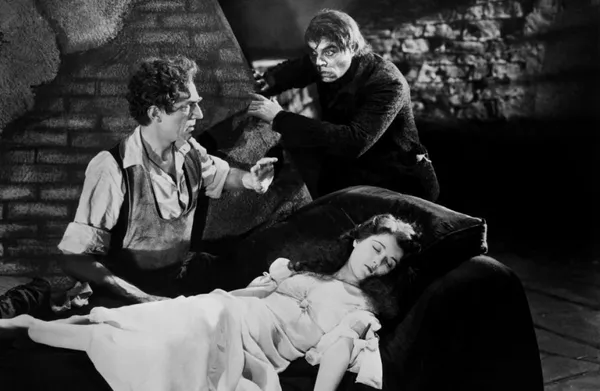Eye For Film >> Movies >> Murders In The Rue Morgue (1932) Film Review
Murders In The Rue Morgue
Reviewed by: Jennie Kermode

Paris has never looked creepier than in this sadly overlooked early Universal horror film - and never less like it does in real life, for all that this was directed by a Frenchman. The influence of early German cinema hangs heavily over it, perhaps because that set so many precedents in cinematic horror. In particular, it's hard to look at the jagged skylines without thinking of Dr Caligari. It's the perfect setting for this curious take on the work of Edgar Allan Poe, and though the film hasn't aged well, with many of its themes no longer hitting home the way they would have done for viewers at the time, there's still much to admire about it.
The early Thirties were a ruthless time in Hollywood. Just as the Great Depression hit, the talkies took off in earnest, and stars who couldn't deliver the vocal performance that the studios were looking for abruptly found themselves on the scrapheap. A new generation of stars emerged, hastily hyped up and, for the most part, short-lived themselves. Among them was Sidney Fox (who would, ironically, make a film called Afraid To Talk just after this one). Like many starlets of her era she spent her career torn between the melodramatic style required in the silent era and the creeping realism that would gradually transform the era. In this, her best known work, she is all about the former, which gave the film an old fashioned quality even on release but which played to her strengths. And if one is required to do nothing more than deliver an image of fragile female victimhood, one might as well make it as deliciously camp as this.
Fox's character is Camille, a modestly well-to-do young woman who chances one day to accompany her beau - Leon Ames' biology student Pierre - to a travelling circus. There she apparently makes quite an impression on captive ape Erik, and certainly on his master, the mysterious Dr Mirakle (Bela Lugosi). Mirakle is, he explains, really a scientist who has made it his mission to prove the reality of evolution. What he doesn't tell the wide-eyed young couple is that his method of going about this involves kidnapping and torturing beautiful young women in his experiments. Viewers, however, will find it easy to discern where this is going.
There are plentiful cliches here - Robert Florey knew how to give his audience what it wanted. The imperilled maidens wear floaty white negligees, faint at the slightest prompting and get tied up in unnecessary ways. A real ape is used to present us with snarling teeth and all that fast-twitch muscle, intercut with a man in a furry suit so we can imagine that Erik is huge and see him grapple with his prey. (Those negligees apparently have velcro panels because he is able to carry women off without using his arms.) Shadows loom large and a random knife fight is supplied as a reminder of more mundane threats. But there is also room for innovation.
Although the film's comedy interludes make for somewhat painful viewing, visually they're fascinating, especially a central scene which produces something close to a 3D effect. Florey is experimenting throughout and there's another scene, where the camera jumps around between buildings, which foreshadows some of Hitchcock's work in Rear Window. The effect of so much innovation can be distracting in places but it's interesting nonetheless, especially as a piece of film history.
Then there is the film's biggest selling point: Bela Lugosi. Enjoying the chance to get away from Dracula and flex his acting muscles for a change, he delivers one of the most interesting performances of his career, doing his duty as an unhinged villain yet also bringing sympathetic qualities to his character, and certainly making him human. His is a formidable presence and he dominates every scene that he's in, yet is always generous to his co-stars, making room for them rather than competing.
Why isn't this film better know? Some critics have suggested that it's because it lacks an iconic monster like those in the bigger Universal hits of the period, and perhaps that's true to a degree, but it seems to overlook the fact that there's something more complicated going on here. It's easy for a modern audience to overlook just what a new idea evolution still was to audiences in 1932. The paradigm shift they were experiencing as they adjusted to the idea of being, at least in potentia, accidents rather than favoured children - combined with the lingering shock of the Great War and the Depression itself - was monster enough. This was an audience with no stable ground beneath it. Florey's film suggests that in that space, anything might happen, Man is recognising himself as the real monster for the first time.
Reviewed on: 22 Jul 2020
















